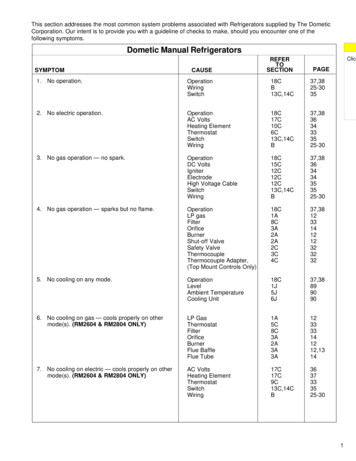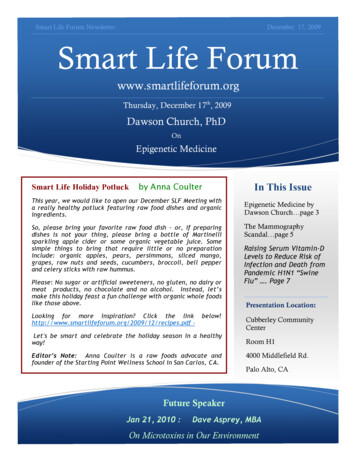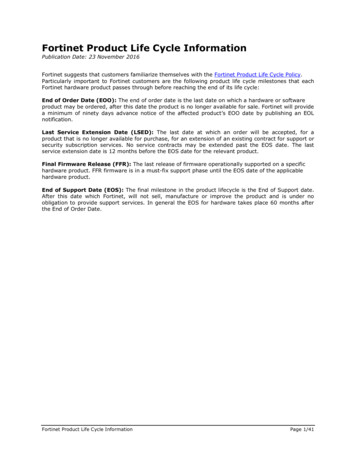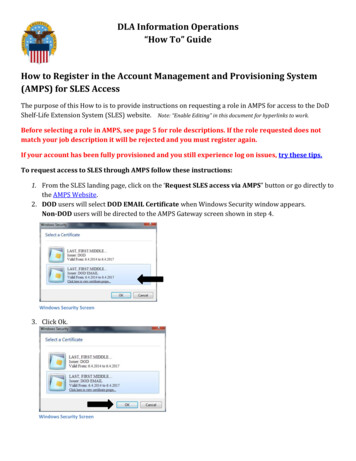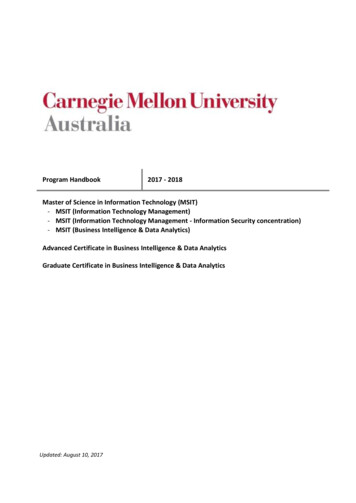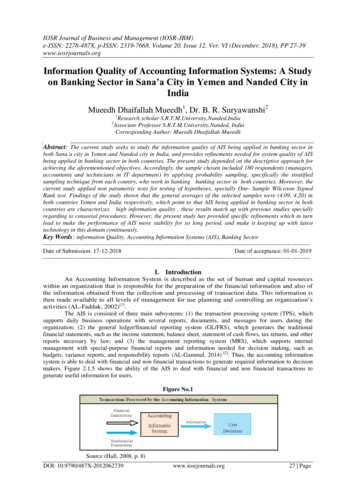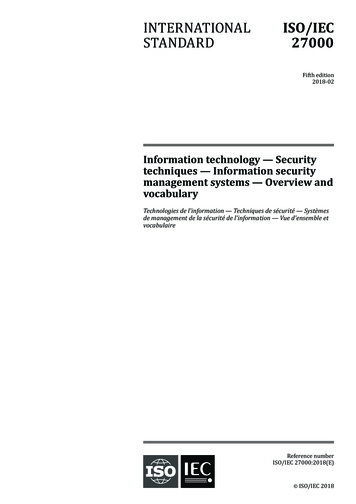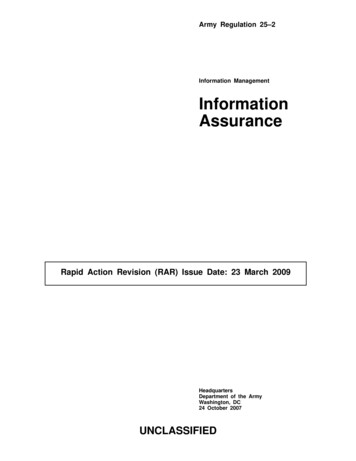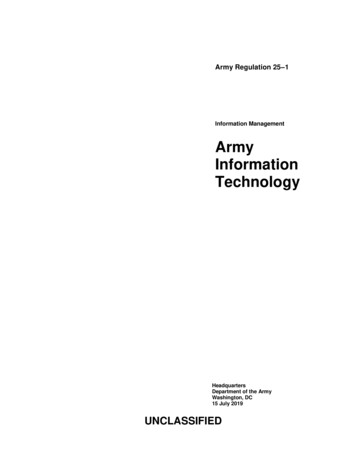
Transcription
BrochureInformation Management and GovernanceBring Informationto Life and Use ItManage information across the lifecycle with Micro Focus Content Manager.
BrochureBring Information to Life and Use ItInformation Is the New Currency of BusinessMany organizations recognize that corporate information is the newcurrency for gaining a sustained competitive advantage and marketleadership. Successfully delivering on business objectives in today’sdynamic and global environment requires you to unlock the value ofinformation by making it accessible to staff and stakeholders acrossthe enterprise. The ability to accomplish this has become increasinglydifficult, as growing volumes of content and diverse formats make theinformation landscape more difficult to navigate and understand. Thereis also added pressure to manage information in line with growing regulatory requirements.Addressing these challenges, Content Manager a governance-basedenterprise content management (ECM) system provides complete information lifecycle management for enterprises across the globe. Builton more than 30 years of information management expertise, ContentManager is a comprehensive, out-of- the-box software solution thatenables you to effectively manage and collaborate on documents andrecords, email, Web content, images, video, and workflows to achievebusiness objectives.Bring Your Information to Life and Unlock Its Full ValueMany organizations look to information governance (IG) as the key to unlocking value from their numerous information repositories. This value,however, changes throughout the information lifecycle and needs tobe considered in your strategy. As a cornerstone of the Micro FocusInformation Governance portfolio, Content Manager is a proven, flexible,and scalable enterprise content management foundation to build yourinformation governance solution.Content Manager facilitates authorized access, collaboration, and management of enterprise content in the context of business processesand transactions. It helps you improve and streamline content workflowso you can remain compliant with organizational and regulatory mandates even with growing resource constraints. The ability to leverageaccurate, contextual, and complete information throughout its lifecycleyields significant value when delivering services to your customers,making business decisions or setting strategy for the future.Content Manager is all about bringing your information to life and managing it as efficiently and completely as possible from creation to disposal,beyond the lifespan of your projects, staff, and business applications.2SInteractive document andrecords managementSharePointgovernanceMicro FocusContent Manager Web UIMicro FocusContent Manager rich clientDocument workflowand collaborationControlPoint forrecords and darkdata identificationSAP ArchiveLinkMicro FocusContent ManagerSDM structured Physical recordsrecords managementCOM/.NET SDKServices APICustom solutionsRetention, management,security, audit, and moreFigure 1. Content Manager use casesSimplify Information Capture, Classification,and ManagementContent Manager offers greater levels of configurability, along withdesktop, workflow, and integration tools to help you perform diversebusiness processes and meet your information governance needs.These capabilities range from the capture of records from structuredbusiness processes such as customer relationship management(CRM), order processing, and HR functions, to highly scrutinized document processes required for freedom of information or data privacyrequests, as well as regulatory submissions and audit.Automatically Declare and Classify ContentContent Manager is capable of automatically classifying content so yourstaff doesn’t have to. Content Manager can be trained on existing documents, the business classification scheme and notes to learn how toidentify and classify new content. Each document is “read” and evaluatedbased on a series of pre-defined categories, weightings and confidencelevels. Once assessed the content is classified and placed into an appropriate folder. In addition, when integrated with Micro Focus ControlPointunmanaged content and records sitting in system repositories can beidentified and automatically declared. Policy is applied to move this information into Content Manager for its ongoing management.The combination of Content Manager and ControlPoint to deliver automatic declaration and classification acts like a safety net to improve thecapture of valuable content and records that may have slipped throughgaps in the process, it also improves the accuracy of applying policyand security.
Control and Connect All SharePoint ContentContent Manager helps you leverage the full value of MicrosoftSharePoint as a collaborative platform by applying management rulesto automate the capture and management of valuable content andrecords without impacting users. A set of conditions are defined toidentify valuable content and records, once satisfied a further set of instructions guide how the object should be created in Content Manager.With Content Manager, you can manage, finalize, relocate, and archiveSharePoint content such as blogs, wikis, discussions, documents,forms, published pages, and sites according to established businessrules. Content Manager allows you to balance the long-term compliance needs of your business—by securing valuable business information—with the day-to-day collaborative needs of staff.Manage Corporate and Legal Filing Structuresin Unison for Enterprise ScalabilityMany ECM systems are limited in their ability to connect legal client fileswith the corporate file plan or business classification scheme (BCS).Thisleads to siloed information, the need to migrate critical content andrecords at some point in time, and limited scalability of the ECM acrossthe enterprise. Content Manager uniquely caters to both corporate andlegal filing structures simultaneously, improving authorized informationsharing and enterprise scalability across business units. With ContentManager, you can link the files within a client matter to the corporatefile plan where the appropriate retention and disposition policies canbe applied automatically.Integrate Information Lifecycle Managementwith Corporate ApplicationsIn order to leverage the full value of information, it makes sense to integrate some corporate applications with the enterprise content management system; for example, this is particularly true if you want to seeall information relating to a specific customer or project. A project fileusually contains emails, proposals, contracts, and plans related to theproject, as well as invoices and other financial documentation linked toeither suppliers or customers. In this situation, an authorized staff hasthe ability to access the project file and view all content within it according to their security and access privileges.Content Manager supports integration with line of business systems viaits published software developer kit (SDK). Integration can be customized to suit your specific requirements or it can be prepackaged suchas the Content Manager SAP integration module.Streamline the Management of SAP RecordsThe Content Manager SAP integration module captures and organizes SAP ArchiveLink documents and SAP metadata into ContentManager automatically, across the enterprise, for review by both SAPand non-SAP users. This capability gives you more efficient information sharing and control of your enterprise SAP information. The SAPintegration module provides an SAP-certified document repository forSAP ArchiveLink, allowing you to store, retrieve, and update SAP information from a single location. The integration lets you store informationfrom SAP ArchiveLink into a container of related information in ContentManager so you get a single view of all the information you need, withouthaving to run the SAP application.www.microfocus.comFigure 2. Client-matter filing structureAccelerate User Adoption and ProductivityKnowledge workers today have higher expectations for interacting withcorporate applications. The bring your own device (BYOD) phenomenonhas driven the need for anytime accessibility across a range of devicesincluding laptops, tablets, and smart phones—with the same level ofinformation security and integrity as internal systems.Deliver Intuitive Web Access acrossa Range of Devices—AnytimeContent Manager offers a modern Web client that is the interface ofchoice for knowledge workers. Utilizing HTML5 technologies, ContentManager’s Web client automatically responds to different devices andpresents information in a layout that is consistent and utilizes the displaylandscape efficiently. This zero-footprint interface is not only easy todeploy, but also supports key user functionality, including dynamic andadvanced search, saved searches, browsing the business classification scheme, document viewing, edit, create, seamless check-in and3
BrochureBring Information to Life and Use Itout, tag and task, workflow, emailing links, advanced record requests,and generating reports. Users have the flexibility to configure the sizeof result lists while also being able to navigate through multiple pages.Improve the Productivity of Mobile Workerswith Geo-Spatial TaggingContent Manager supports a GPS location property for objects (content and records) and locations (people and organizations) under itsmanagement. There is a multitude of opportunities to leverage the GPSlocation property to better manage assets or properties at specific locations for organizations such a Local Government, Oil & Gas, Powerand Water, Utilities, Mining and Property Management companies.This GPS location property can be used to link or find content associated with single or multiple geo-points which will be particularly usefulfor mobile workers. Users may wish to find all content associated witha specific location or an area (such as a National Park) and by usingthe quick-select tool they can easily select the points of interest fromGoogle Maps. Content Manager will return all objects the user is authorized to access associated with the location.Save Time Onboarding Users with “Instant On” AccessContent Manager’s “Instant On” feature allows you to pre-configure access permissions for new users that haven’t been entered into the system. The user is prompted to register themselves and provide relevantuser information based on a login template. To provide better controlof access, this function can be limited to users that belong to specificdomains.Alternatively, a new user may log in to Content Manager as a guest withcredentials and security set according to the specific login name thatis used.Improve Access and Productivitywith Seamless Desktop IntegrationContent Manager is integrated with industry-leading authoring, messaging, and collaboration applications such as Microsoft Office, SharePoint,Outlook, and Lotus Notes Mail. Integration with line-of-business applications such as SAP helps you to easily capture, update, and reuse thisbusiness information.Microsoft-style ribbons, shortcut, and quick access toolbars allow users to customize their desktop experience and streamline day-to-daydocument creation, editing, and retrieval processes.4Figure 3. Searching with geo-spatial markers on Google MapsContent Manager is adaptable to diverse business processes and information management needs and can be extended through integrationtools such as the SAP ArchiveLink integration module, external warehouse integration (Iron Mountain and oneilBridge), and the SharePointcompliance app.Capture and Manage Your Email—Automatically, Seamlessly, and EfficientlyYou can easily file, retrieve, and work with email content in exactlythe same way you work with Microsoft Office documents. ContentManager’s advanced email integration uses message IDs in MicrosoftOutlook and Lotus Notes email to identify duplicate messages and prevent them from being captured multiple times. Minimizing the numberof duplicate emails captured significantly reduces information footprint,search retrieval times, and associated costs.
Optical Character Recognition Makes Images SearchableContent Manager’s optical character recognition (OCR) module leverages the IDOL Image Server to either manually request an OCR renditionor by automatically processing image files within the indexing process.When an image file is detected it is sent to the IDOL image server fortext extraction, then the text file is stored as an OCR rendition of theoriginal, which can be easily searched.Figure 4. Navigation within Microsoft Outlook email conversationThe capture of conversation IDs assigned to Microsoft Outlook emailsin the form of metadata simplifies the navigation and search for emailswithin a single conversation thread.There are Content Manager integrations with both Microsoft Outlook(Exchange 2010, 2013, and Exchange Online) and Lotus Notes emailthat are completely server side. This means you don’t have to installContent Manager software on user email clients, which removes muchof the deployment and maintenance burden from IT. The integration automates the capture of email from the user’s email account into ContentManager through a series of dynamically linked folders, which appearin the user’s email client.Improve Efficiency and Enterprise PerformanceInformation is probably one of the most valuable assets in an organization. Taking advantage of this critical corporate asset through competentlifecycle management can enhance your ability to meet governance andregulatory compliance obligations, and gain a competitive advantage.Content Manager helps you to manage business content and records efficiently, physical and electronic, regardless of source. Automated rules,classification, and workflow capabilities facilitate the easy capture, management, and discovery of your business content from creation to disposal, improving staff efficiency, security, and enterprise performance.Save time with Powerful and Extensive SearchContent Manager offers powerful, extensive built-in metadata that usesstrong relational capabilities and Micro Focus IDOL-powered indexing tohelp you quickly and easily locate business information. Search speedcan be improved by configuring Content Managers’ IDOL indexes toboost operational efficiency and worker productivity as they interactwith information. Staff can find business documents and records faster,with greater accuracy and relevance. Saved searches can be created onan individual or enterprise-wide basis to simplify the process of runningregular or multi-faceted searches.www.microfocus.comFigure 5. OCR options in Micro Focus Content ManagerAutomatic Records Classification and Folder CreationIncrease Filing Accuracy and EfficiencyContent Manager has the ability to classify content and records automatically based on detailed IDOL categories. Sub-folders can be automatically created according to predefined rules so newly classified contentis placed into a folder as opposed to being attached directly to the classification term. Auto-classification improves both filing efficiency andaccuracy, removing the manual and error-prone task from staff.Content Manager’s integration with ControlPoint facilitates the identification and declaration of valuable content and records sitting outside of theContent Manager repository found in other enterprise systems. Whenthis content is declared, it is moved into Content Manager and assigneda holding classification. Once indexed, Content Manager auto-classifiesthis content according to detailed IDOL categories and moves them to anappropriate folder or creates a new folder as needed.Manage in Place Where Content Offers Most ValueIt doesn’t always make sense to move critical content and records intoa central repository, there are times when the content is best left in theauthoring application where it offers the most value. Content Manager5
BrochureBring Information to Life and Use ItContentrepositoriesManage in intDeclareIndex, analyze,auto-classifyIDOL Connector Frameworkuses a manage-in-place framework to apply holds to content in externalrepositories without the need to migrate it to a central repository. Whenon hold, Content Manager takes control over the contents retention andsecurity. This in-place management feature leverages the IDOL ConnectorFramework and supports any subscribing repository.ContentManagerIDOLFigure 6. Content Manager manage-in-place frameworkOptimize Storage to Improve Scalability and ResponsivenessThe overwhelming volume of human information being created and consumed in the course of daily business activities requires greater scalabilityand performance from your enterprise systems. Now more than ever, youneed to be able to manage even larger record sets while providing timelyaccess for staff potentially across hundreds of global locations.Content Manager offers document stores that have been designedto balance the need for highly responsive, fast document capture andretrieval with the use of cost-effective secondary storage. Configurabledocument caching, distributed stores, and tiered storage delivers optimum responsiveness for users and increased, efficient performancefor the business.Coupled with single instancing for email and documents you can significantly reduce duplication of this information and the overall volumeof content to be stored.6Simplify DeploymentReduce Deployment and Maintenance Overheadswith Zero-Client InstallMany organizations work with constrained or shrinking IT budgets thatdrive the need to simplify deployment and maintenance of enterpriseapplications. Content Manager offers zero-footprint (thin) and desktopclient interfaces so you can satisfy: User and administrator functionality requirements Enterprise application integration needs IT deployment constraints and goalsContent Manager’s zero-footprint Web client requires zero install and supports the record and document management needs of daily contributorsand collaborators. Through the Web client, users can—search, view, tagand task, edit, create, check-in and out, access, complete workflow tasks,email document links, request physical records, and generate reports.With email being one of the primary communication tools for staff (whereconversations are now documented and transmitted instead of beingspoken verbally), this means that email applications are typically deployed on all PCs and laptops within the organization. For organizationsthat must capture, access, and manage all employee email, ContentManager’s server-side integration with Microsoft Exchange (2010, 2013,and Exchange Online) and Lotus Notes email remove the need for clientsoftware installation. It also lessens the burden and cost of IT.Support Hybrid and Cloud InitiativesMany organizations are looking at Office 365, SharePoint 2013, andeven Google Apps as their first step toward the cloud. But, how do youmake sure your documents and records are being managed according to global standards and regulations while taking advantage of whatcloud has to offer? Content Manager is evolving to support the hybridand cloud goals of organizations around the world, balancing the needfor records security, control, and integrity with usability.Office 365 and SharePoint 2013 IntegrationContent Manager integrates with Office 365 via the desktop client andwith Exchange Online via a server-side integration. The integration withSharePoint 2013 is achieved through Microsoft’s remote client-sideobject model that utilizes an app for deployment. The Content ManagerSharePoint integration is transparent to users, having a similar look andfeel to SharePoint 2013 and Office 365.
you mitigate risk and support compliance initiatives. Retention rules canbe applied across multiple jurisdictions, so the process of determiningwhat records can be destroyed can be automated, running as a centrallycont
Manager is a comprehensive, out-of- the-box software solution that enables you to effectively manage and collaborate on documents and records, email, Web content, images, video, and workflows to achieve business objectives.
